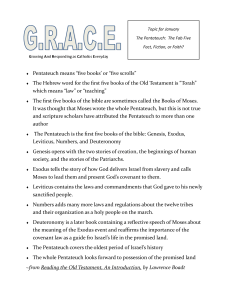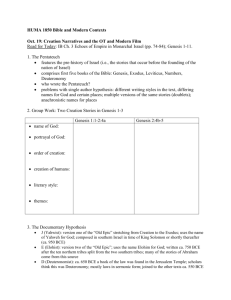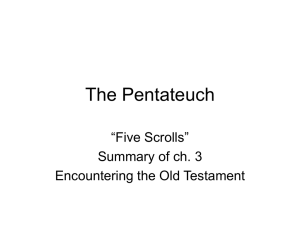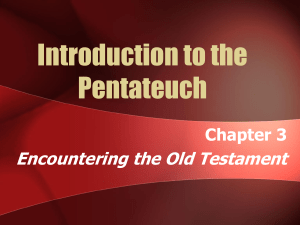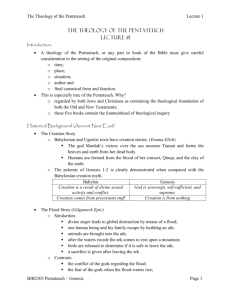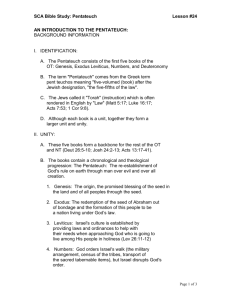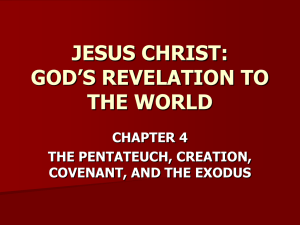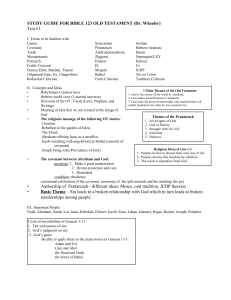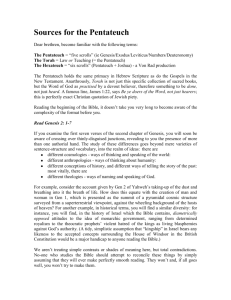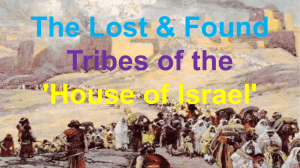Introduction to the Pentateuch
advertisement
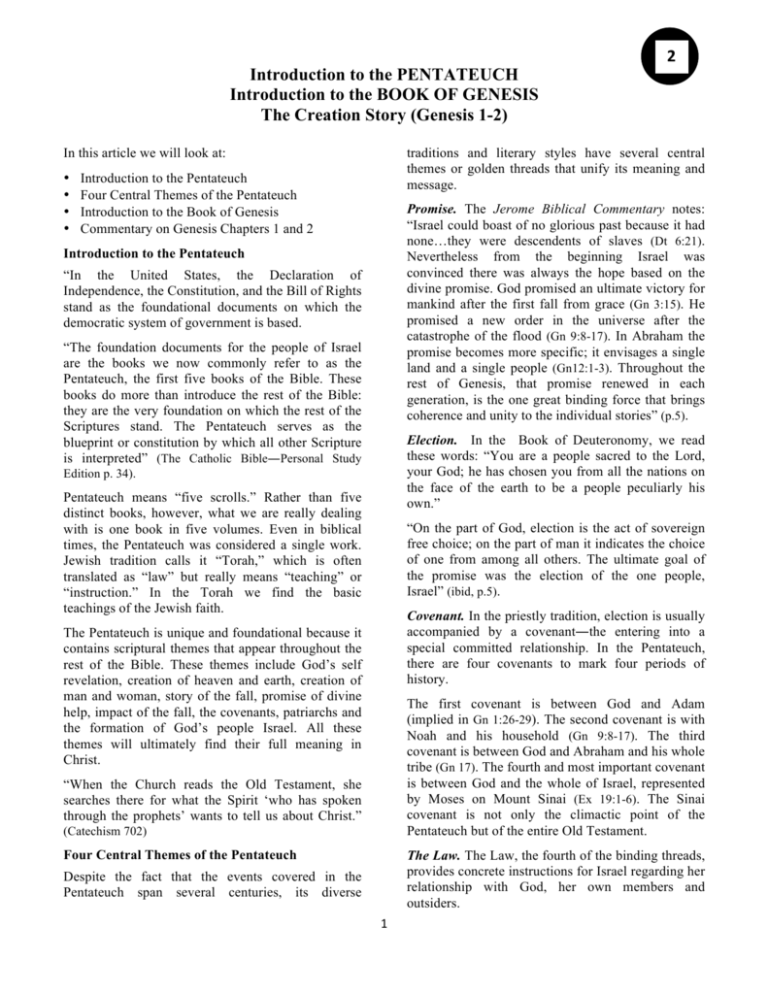
Introduction to the PENTATEUCH Introduction to the BOOK OF GENESIS The Creation Story (Genesis 1-2) In this article we will look at: • • • • traditions and literary styles have several central themes or golden threads that unify its meaning and message. Introduction to the Pentateuch Four Central Themes of the Pentateuch Introduction to the Book of Genesis Commentary on Genesis Chapters 1 and 2 Promise. The Jerome Biblical Commentary notes: “Israel could boast of no glorious past because it had none…they were descendents of slaves (Dt 6:21). Nevertheless from the beginning Israel was convinced there was always the hope based on the divine promise. God promised an ultimate victory for mankind after the first fall from grace (Gn 3:15). He promised a new order in the universe after the catastrophe of the flood (Gn 9:8-17). In Abraham the promise becomes more specific; it envisages a single land and a single people (Gn12:1-3). Throughout the rest of Genesis, that promise renewed in each generation, is the one great binding force that brings coherence and unity to the individual stories” (p.5). Introduction to the Pentateuch “In the United States, the Declaration of Independence, the Constitution, and the Bill of Rights stand as the foundational documents on which the democratic system of government is based. “The foundation documents for the people of Israel are the books we now commonly refer to as the Pentateuch, the first five books of the Bible. These books do more than introduce the rest of the Bible: they are the very foundation on which the rest of the Scriptures stand. The Pentateuch serves as the blueprint or constitution by which all other Scripture is interpreted” (The Catholic Bible―Personal Study Election. In the Book of Deuteronomy, we read these words: “You are a people sacred to the Lord, your God; he has chosen you from all the nations on the face of the earth to be a people peculiarly his own.” Edition p. 34). Pentateuch means “five scrolls.” Rather than five distinct books, however, what we are really dealing with is one book in five volumes. Even in biblical times, the Pentateuch was considered a single work. Jewish tradition calls it “Torah,” which is often translated as “law” but really means “teaching” or “instruction.” In the Torah we find the basic teachings of the Jewish faith. “On the part of God, election is the act of sovereign free choice; on the part of man it indicates the choice of one from among all others. The ultimate goal of the promise was the election of the one people, Israel” (ibid, p.5). Covenant. In the priestly tradition, election is usually accompanied by a covenant―the entering into a special committed relationship. In the Pentateuch, there are four covenants to mark four periods of history. The Pentateuch is unique and foundational because it contains scriptural themes that appear throughout the rest of the Bible. These themes include God’s self revelation, creation of heaven and earth, creation of man and woman, story of the fall, promise of divine help, impact of the fall, the covenants, patriarchs and the formation of God’s people Israel. All these themes will ultimately find their full meaning in Christ. The first covenant is between God and Adam (implied in Gn 1:26-29). The second covenant is with Noah and his household (Gn 9:8-17). The third covenant is between God and Abraham and his whole tribe (Gn 17). The fourth and most important covenant is between God and the whole of Israel, represented by Moses on Mount Sinai (Ex 19:1-6). The Sinai covenant is not only the climactic point of the Pentateuch but of the entire Old Testament. “When the Church reads the Old Testament, she searches there for what the Spirit ‘who has spoken through the prophets’ wants to tell us about Christ.” (Catechism 702) Four Central Themes of the Pentateuch The Law. The Law, the fourth of the binding threads, provides concrete instructions for Israel regarding her relationship with God, her own members and outsiders. Despite the fact that the events covered in the Pentateuch span several centuries, its diverse 1 2 The Pentateuch―a blending of four traditions. In reading the Pentateuch closely, it is apparent that some stories or events are told more than once. For example, there are two accounts of creation (Gn 1:1-2, 4 and 2:5-25); two versions of the Great Flood blended together (Gn 6-9); two accounts of Abraham’s attempt to save himself in a foreign land by misrepresenting his wife Sarah as his sister (Gn 12:1020 and 20:1-18); two accounts of Abraham sending out Hagar with her son Ishmael to the desert (Gn 16 and 21); two versions of the Ten Commandments (Ex 20:1-14 and Dt 5:6-18). Why do we find two versions of the same story several times in the Pentateuch? family”: the patriarchs and matriarchs of the Israelite nation. Genesis 12-50 is usually subdivided into stories of the Patriarchs: the story of Abraham (Gn 12-25), the story of Isaac and Jacob (Gn 26-36), and the story of Joseph (Gn 37-50). In its introduction to Genesis, the Collegeville Bible Commentary states: “The dominant form of narrative in the Book of Genesis is the saga. Sagas are stories that have a basis in fact, but as the stories are transmitted, they are expanded and enhanced by nonfactual elements. Sagas originate at an oral level combining tradition and imagination. It is not unusual to find reported in a saga the direct intervention of God in human affairs. In saga the incredible is simply part of the flow of events” (p.37). Scholars wrestled with this question for centuries until they discovered that in the Pentateuch, we have four historical traditions or sources. These traditions or sources are called Yahwist, Elohist, Priestly and Deuteronomic, usually abbreviated as JEPD. (In German, Yahwist is spelled “Jahweh,” hence the J.) Two accounts of the creation story. When we read Genesis 1 and 2, we observe two accounts of creation. Why is this? (As we read earlier, the final editor of the Pentateuch drew on four traditions― JEPD.) At the time of the writing of the Book of Genesis, two accounts of creation existed: J and P. Rather than choosing one account, the final editor included both. Having the two versions of the creation story in the final edition of Genesis suggests that the editor was not interested in telling us how the world was created. His intention was to communicate important religious truths and to respond to questions his people were asking at the time. Commentaries on the first five books of the Bible often refer to these four sources or traditions. Some chapters of the books are completely written in one of the traditions, e.g., Genesis 1 (Priestly), Genesis 2 (Yahwist), but other chapters are a mixture of two or more traditions, e.g., Genesis 6-9 on the Great Flood (Yahwist and Priestly). [When it comes to group sharing of specific sections, you can always ask in addition to the questions provided: What spoke to you most in the above texts or verses?] Chapter 1:1-­‐2:4 – Priestly account of creation Introduction to the Book of Genesis “In the beginning God created the heavens and the earth… And God saw that everything that he had made, and behold it was very good.” (Gn 1:1, 31) [You are encouraged to read the biblical text before you read the commentary.] The first creation story was probably written later than the second account, perhaps during the time when the Israelites were in exile and doubted if God was in control of events anymore. This account of creation, which flowed from the Priestly tradition, is a very strong statement about the power of God―the One who created the heavens and the earth and controls all things. The Priestly writer wanted to communicate to his people that despite Israel’s current misfortunes (while in exile), God was very much in control of his world. The first book of the Bible opens with the words: “In the beginning…” Genesis is a book about beginnings: beginning of the natural world, beginning of humans and human culture, beginning of sin and suffering and death, beginning of Israel, whose story dominates the rest of the Old Testament and, in a sense, the rest of the Bible. Division of chapters Part 1: Creation and the Fall (chapters 1-11). These chapters are often called primeval history because the events described occurred before recorded history. Before God began his great work of creation, there was a “formless wasteland” and “a darkness which covered the abyss or deep waters” (Gn 1:2). Darkness and undifferentiated waters represent chaos. But then a “mighty wind,” often translated as God’s spirit, Part 2: The Patriarchs (chapters 12-50). These chapters tell the story of Israel’s “first 2 sweeps over the chaos and brings about order, beauty and goodness. In Gn 1:3, the author writes: “Then God said, ‘Let there be light,’ and there was light. God saw how good the light was.” Through the six days of creation, God is speaking, executing and proclaiming the goodness of all that he has created. mood in the J story. Where the P account moves toward the creation of humanity as its climax, the J writer begins with God’s creation of the man, and describes how subsequently God builds up a world for his new creature. In reality, J presents two stories. The first is the story of how God created one human being, but saw that he needed companions. God made a garden, but it was not enough; then he made the animals, and they did not prove enough; finally he made woman from man’s flesh and human community was created, and it was enough. If we study the first account of creation carefully, we see that the six days of creation are divided into two sets of three days. During the first three days of creation, God is building a vast stage of the heavens, water and land, separating one from another. During the second three days, God populates and decorates what he has just created. Creation becomes one decorated whole (see chart on page 5). The goodness of creation is celebrated on the seventh day. “The second story tells how God gave humans care over the garden and made everything perfect for them. It sets the stage for the sin of the first human couple. The author speaks almost as in a fairytale. God walks with his man and woman and talks to them, he thinks out loud, he works as a potter, fashioning people from mud and breathes life into them. There is a concrete sense of closeness to the earth about the storyteller’s manner in the J account” Scholars tell us that the authors of the first account used the story of the six days to emphasize the importance of resting on the Sabbath. God is imaged as a Hebrew laborer who works for six days and rests on the seventh. If God rested on the seventh day or Sabbath, surely the Israelites should do the same. (pp.18-19). Man is made of clay and God’s spirit. Gn 2:7 states: “The Lord God formed man from the clay of the ground and blew into his nostrils the breath of life, and so man became a living being.” Man is different from the rest of the animal world. He is composed of two elements: matter and spirit. Scholars like to point out the relationship between man and the earth. The Hebrew word for man is Adam and for the earth is adamah. The wordplay expresses the relationship between the man and the earth. When man sins, an alienation occurs between him and the earth (Gn 3:1719). “God created man in his image…male and female He created them.” (Gn 1:27). “In figurative and symbolic language, scripture describes God creating the first man and woman, Adam and Eve, and placing them in Paradise. They were created for friendship with God and in harmony with creation.” (USC p.37) Pause: Creation spirituality focuses on how we relate to God through nature. Many people connect with God in and through the beauty of our physical world. To what extent is enjoying nature a part of your spirituality. CHAPTER 2:5-­‐25 – Yahwist account of creation Creation of the woman (Gn 2:18-24). These verses begin with God saying: “It is not good for man to be alone.” Adam is incomplete without Eve. The woman is created from the rib of the man, which is intended to demonstrate the closeness and solidarity between the man and the woman. The term helper does not imply inferior assistant but rather a genuine partner that comes to the aid of the other. The man and the woman are equal partners in life’s journey. “This one, at last, is bone of my bones and flesh of my flesh; this one shall be called ‘woman,’ for out of ‘her man’ this one has been taken. “That is why a man leaves his father and mother and clings to his wife, and the two of them become one body. In his book, Reading the Old Testament, Fr. Lawrence Boadt introduces us to this account of creation in this way. The four rivers (Gn 2:10-14). Scholars are not sure why these verses, which speak of four rivers in the Garden, are inserted into the story. Its purpose might be to link the Garden of Eden to a specific location. Only two of the rivers are known today: the Tigris and Euphrates. Water, of course, is always a sign of life and blessing, a part of God’s creation. “After the solemn tones of the Priestly creation narrative, the reader notices a definite change in Two special trees (Gn 2:9, 16-17). In the Garden of Eden (Hebrew word for “luxury” or “delights”) grow “The man and his wife were both naked, yet they felt no shame.” (vv 23-25) 3 two special trees: (1) the tree of life which symbolizes man’s immortality, and (2) the tree of knowledge of good and evil of which God explicitly tells Adam not to eat. There is debate amongst scholars as to the meaning of the “tree of knowledge of good and evil.” Some believe it refers to man’s ability to know right from wrong. But why would God want to deny us such knowledge? Hence, some scholars think that the ‘tree of knowledge of good and evil’ has to do with knowledge that belongs to God. When God tells the man not to eat of the fruit of this tree (Gn 2:17), he is telling him not to set his sights on divine status. Man should remember his creature status and his dependence on God for everything. To eat of the fruit of the tree of knowledge of good and evil is to seek to take on divine status. we do believe that God breathes a soul into every person at the moment of conception (Gn 2:7). The United States Catholic Catechism for Adults states: “Christian faith does not require the acceptance of any particular theory of evolution, nor does it forbid it, provided that the particular theory.…does not deny….that God creates each human soul directly to share immortal life with him” (p.60).The purpose of the Bible is to show us how to go to heaven and not to tell us how the heavens go. Lessons from the two creation stories. Again, the interest of the final editor of these chapters was not to give a scientific account of how the world was created but rather to communicate some important theological and religious truths such as the following: • There is only one God who existed before everything else, and he created everything, including the sun, and the moon which Israel’s neighbors in Babylon would have worshipped. We might also say that God’s command to the man is a boundary issue, a freedom issue. The man is being told he is free to obey God or disobey him. Disobeying him will have dire consequences. Hence, human freedom is not freedom to do as we like. Rather, it is the freedom to do as we ought, the freedom to choose well, to follow God’s ways and receive the blessings that come with making such a choice. In the next chapter of Genesis, we will see how sin involves the misuse of freedom. • God is a God of order. In the first creation story, everything is carefully ordered. • God has an intellect and will. He is not some force of nature. He is a personal God and can be loved and served with devotion. • The world and everything in it is created good and therefore should be enjoyed and celebrated. Meditation on the beauty of creation should lead us to praise the Creator. God, creator of marriage and sexuality. The second account of creation ends with these words: “That is why a man leaves his father and mother and clings to his wife and the two of them become one body. The man and his wife were both naked, yet they felt no shame” (Gn 2:24-25). • Humans are the masterpiece of God’s creation. They are given dominion over the animal world and the earth, which albeit are not to be abused or misused but to care for in a way that would please God. Knowing that we are created in God’s image and share many of his characteristics, provides a solid basis for a true sense of self-worth. True human worth should not be tied to what we own or what we do, or to our looks, but to our creation in God’s image and likeness. These verses are intended to explain why the man and the woman were sexually attracted to each other and had a desire to marry. Drawing on this verse, the Church teaches that marriage is an institution between one man and one woman, and ideally a union that should last until the death of one of the spouses. The final verse about being “naked and unashamed” is a bridge verse to the fall of Adam and Eve. After they sin, they become ashamed of their nakedness and cover themselves in fig leaves. • Human labor has godly value. When engaged in work, we are co-creating the world with God. • Rest from labor is important so that we take time to worship God and enjoy his creation. Creation and evolution. The German astrophysicist, Wernher von Braun, once said: “Through science, man strives to learn more of the mysteries of creation. Through religion, he seeks to know the Creator.” Catholics can believe that the human body evolved from lower forms of life – all part of God’s plan to form the world from the dust of the earth. But • The sacredness of sexuality and marriage. Pause: Which of the above eight truths speaks to you the most? 4 Three Days Of Separation Three Days Of Integration/Decoration DAY 1 God creates the heavens and separates light from darkness DAY 4 God decorates the sky, sun, moon and stars DAY 2 God separates the waters above (rain) from the waters below (ocean) DAY 5 God creates the birds for the air and fish for the ocean DAY 3 God separates the dry land from the waters below and adds vegetation to the land DAY 6 God creates and populates the land with animals and HUMANS DAY 7 Epilogue: God rests, fully in control of all creation. This day becomes the model of rest and celebration of God’s goodness that humans are to follow each week. 5
